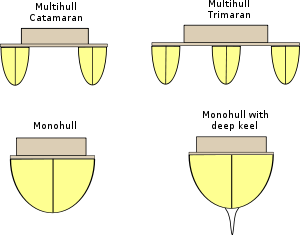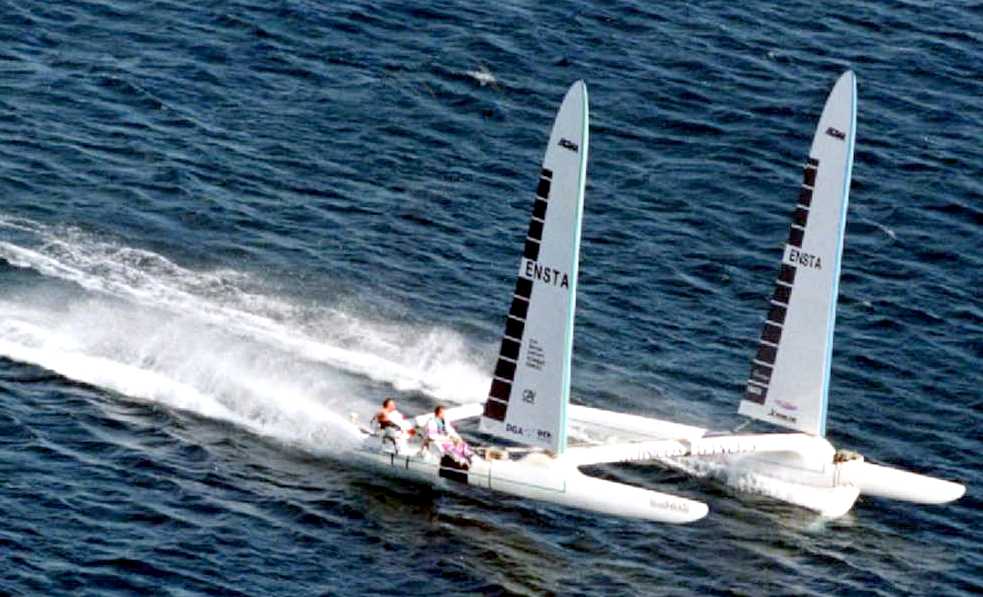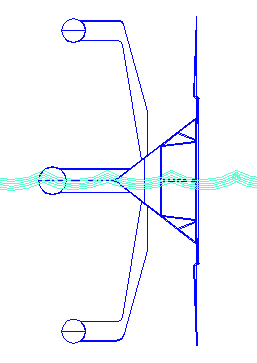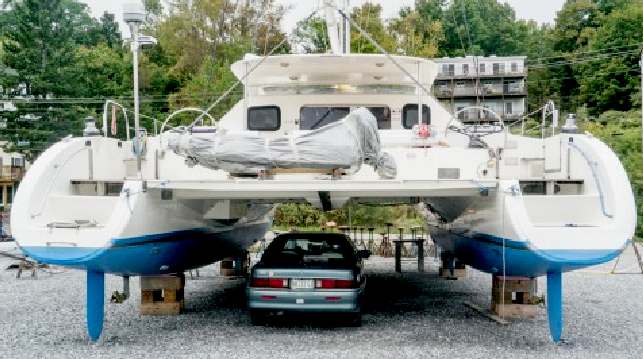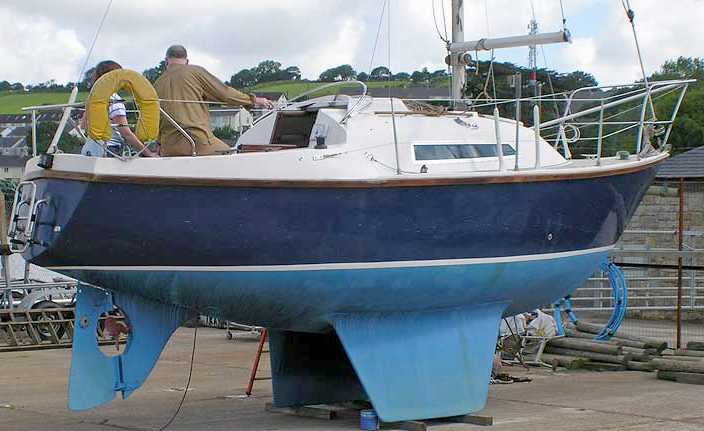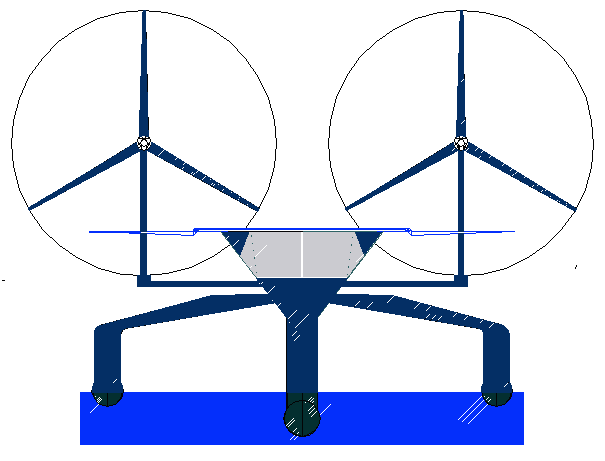|
MULTIHULLS
|
|
|
A multihull is any vessel with more than one hull. Additional hulls provide stability to hold a vessel upright, most notably against the sideways force of the wind from sails. By contrast monohulls use a keel and/or ballast to counteract wind induced heel.
Multihull ships (vessels, craft, boats) comprise a great variety of types, sizes and applications. A very specific sub-group of multihulls is the Small Waterplane Area (SWA) multihulls. A twin-hull version of this subgroup is commonly known as
SWATH
(Small-waterplane-area twin hull). At the present time, the main interests in shipbuilding and shipping industries of multihull vessels are focused on engine-powered ships.
Multihulls include: proas with two differently sized hulls, catamarans, and trimarans, which have a larger hull in the center and two smaller ones on either side.
Multihull sailing boats are usually very much wider than a monohull of similar draft, hence need no ballast. The reduced hull drag makes them faster than monohulls that may be raced in the America's Cup and Volvo ocean races.
Each type of multihull differs from the other and from the monohulls. For example, a catamaran has the biggest transverse stability of all ships of the same displacement. A duplus has the biggest transverse stability of all SWA ship types. A trisec can have the smallest waterplane area of all multihulls and monohulls of the same displacement. A catamaran with longitudinally shifted hulls and any triple-hulled ships can ensure the most favorable interaction of wave systems generated by the vessel at speed. A ship with outrigger(s) (proa or trimaran in Western sense) can have the smallest relative mass of hull structures.
POWER
Catamaran and trimaran multihull forms are also used by power-boaters. Pure power catamarans are now a common sight in the Caribbean and Mediterranean as charter fleets. There are also super catamarans, a definition reserved for boats over 60 feet in length. Such designs are now reported widely on websites as www.catamarans.com and www.2hulls.com. Solar Navigator was originally a catamaran, as is PlanetSolar.
NEGATIVES
The width of a multihull can be a problem when docking. They are also more expensive to produce than an equivalent monohull.
It is held that in the open ocean, multihull craft are less safe. If a storm capsizes a small monohull it can in some cases recover, if it does sink. Multihulls can capsize but they rarely sink. Thye are though difficult if not impossible to self right and/or launch deck-mounted liferaft or emergency radio. Pitch-poling is another risk in a multihull, where the bow of the boat dives into a wave so deeply that the stern permorms a forward somersault.
SMALLER POPULAR BOATS
Among the small sailing catamarans, also called beach catamarans, the most recognized racing classes are the Hobie Cat 16, Formula 18 cats, A-cats and the olympic multihull called Tornado. Larger boats include Corsair Marine (mid-sized trimarans), and Privilege (large, luxurious catamarans) and the much larger French trimarans of the ORMA racing circuit.
The
Seawind, Perry, Lightwave production catamarans from Australia, The largest manufacturer of large multihulls is Fontaine-Pajot in France (the much larger French trimarans of the ORMA racing circuit and round the world record attempts are included in this total).
This autonomous SWASH hull design can self-right robotically
NEW Vs OLD
It's strange how progress is held up by traditionalists. When Nathanael Herreshoff thrashed the competition in a New York regatta with a 25ft catamaran called Amaryllis, he was banned from future races. This happened in the automotive world when rear engined cars that beat front engined cars were banned to begin with.
"The
nondescript, half-Catamaran, half-Balsa and wholly life-raft
constructed by Mr. Herreshoff, of Providence, whether ruled out by the
judges or counted in, can justly claim to be the fastest thing of her
inches under canvas that floats, and it is doubtful if there are any
steamers of her size that could out-speed her in a straight reach with the
wind abeam. Whether she is ruled out of this race or not need make but
little difference to her owner, as he can justly lay claim to a medal and
diploma of the Exposition as presenting the fastest sailing craft in the
world: That she is this every one of the many thousand that witnessed her
performance yesterday will admit."
In 1937, a Frenchman built a 35’ double canoe in Hawaii and made an epic 264-day voyage back to his homeland via the Indian Ocean. In the late 50s the groundwork was re-laid for the popularity of multihulls by James Wharram, when he crossed the Atlantic in a 23-foot Polynesian-style catamaran that he built for just $420. After this James made a circuit from the Caribbean to New York and to England in a 40-footer named Rongo. Soon after Arthur Piver made an Atlantic crossing in a simple home built trimaran in the ‘60s.
Since N. G. Herreshoff, in 1877, many have been convinced about the superiority of multihulls. In 1978, 101 years after catamarans like Amaryllis were banned from any and all forms of yacht racing history was to prove them right. Starting with the victory of the little trimaran Olympus photo, skippered by Mike Birch in the first Route du Rhum. Light and slender Olympus photo seemed to devour the sea, running away from all other types of boats. No great open ocean race would be won by a monohull, ever again. In addition, winning times have dropped by 70%, since 1978, from Olympus photo's 23d 6h 58'35" to Gitana 11's 7d 17h 19'6", in 2006. SAILOR'S CHOICE
This is equally valid for a solar boat with large flat panel areas. Where monohulls solve the stability problem with a heavy keel of lead and more hydrodynamic drag; multihulls use mechanical advantage in the positioning of buoyancy away from the centerline of the boat - the resulting leverage (buoyancy thus generated) must equal the force of the wind with something in reserve.
One
advantage of a catamaran we'd not come across: a garage
PERFORMANCE
Without a lead keel, multihulls weighs considerably less than a comparable monohull. Less mass = less wetted surface area to cause water drag as faster acceleration. When a boat moves through the water, it creates a bow wave and a stern wave, and at some point it can get trapped between the two. The length of a boat therefore determines practical speed. This natural phenomenon is known as the boat’s hull speed, or the speed length ratio. The value can be determined with a simple formula: 1.34 times the square root of the waterline length for a typical boat shape, that becomes less applicable to ultra thin hulls.
Unless
a boat has
enough power to plane above the
water, a monohull is caught in its own wave trough. That said, the length of the waterline may change considerably
when a sailboat is heeled over in
the wind—many racing hulls are deliberately designed to do this
as a sort of rule-bending ruse.
"In
a sense, hull speed is related to going supersonic—exceeding the wave
propagation limit of the medium you are traveling through. This is
really a statement about how fast you can go before you must push water
aside faster than it can get out of its own way."
Multihull sailing involves
a different set of skills from monohulls where traditional tactics may backfire.
Tacking a sail powered multihull can be tricky, as long thin hulls are harder
to turn and the lighter hulls have less inertia to carry a boat
through if not executed with skill. A solar
powered electric vessel avoids the need for such skills. In the case
of the Solar Navigator, the vessel can
automatically counter for such situations. PlanetSolar
managed to contend with all situations when setting the first solar
powered multihull record in May of 2012.
STABILITY
When the wind is blowing from one side or the other multihulls sail flat and monohulls sail heeled over. Sailing flat is more comfortable for most sailors. Crockery and maps don't slide off work surfaces. This may reduce the excitement for the purist but here we are talking about stability.
Exploration of shallow waters is likely to lead to grounding - monohulls need more care when beaching.
SAFETY
Some
multihulls are designed to be self righting, such as the Solar
Navigator. However, this design is still under industrial
development.
It helps if the crew of a vessel has some underwater experience. Every sailor
should undertake some basic diver
training.
The
Solar
Navigator can flood compartments to lower itself in the sea, where the
hull acts like a giant sea-anchor.
Monohulls need more care when beaching
CATAMARAN vs. TRIMARAN
With the above in mind it should be clear that if you are looking for performance, you should be considering a multihull. Then there is the choice between catamaran and trimaran.
Sailing catamarans usually also have two sets of control surfaces: centerboards and rudders. Trimarans may have three hulls, but the outers can be simple floats devoid of complications. Catamarans with a central rig must be stronger to make up for a weaker structure, unless a boat is set up with two rigs as per Team Phillips, which proved rather more complex than the designers envisaged - even though it performed well before delamination.
The main hull of a trimaran is a torque tube, with centralized torsion and better load distribution. Trimarans are also less prone to under-wing slamming, since the gaps between floats are narrower.
SMALL
WATERPLANE AREA DESIGN
REFERENCE and LINKS
http://en.wikipedia.org/wiki/Multihull MYCQ - Multihull Yacht Club Queensland - Australia's leading Multihull club http://www.catsailor.com/forums/ubbthreads.php - the most active forum page for all small sailing catamarans (beach cats). http://www.cruisincats.com/ Cruisincats.com - 101 reasons why catamarans are better,faster and sexier than... http://www.catamarans.com/ World's largest exclusive catamaran site http://www.supercatamarans.com/ Home of the mega catamaran http://www.multihull-maven.com/ Articles and news on multihulls, profiles of boats, designers, yards, etc. http://www.catamaran.co.uk/main.htm http://www.sailing.org/ International Sailing Federation A list of different hull designs http://www.boatdesign.net/forums/multihulls/historical-multihulls-42019-3.html http://www.f-boat.com/safety/
A taste for adventure
Solar Cola - a healthier alternative
|
|
|
This website is copyright © 2014 Electrick Publications. All rights reserved. The bird logo and names Solar Navigator and Blueplanet Ecostar are trademarks ™. The Blueplanet vehicle configuration is registered ®. All other trademarks hereby acknowledged and please note that this project should not be confused with the Australian: 'World Solar Challenge'™which is a superb road vehicle endurance race from Darwin to Adelaide. Max Energy Limited is an educational charity working hard to promote world peace.
|
